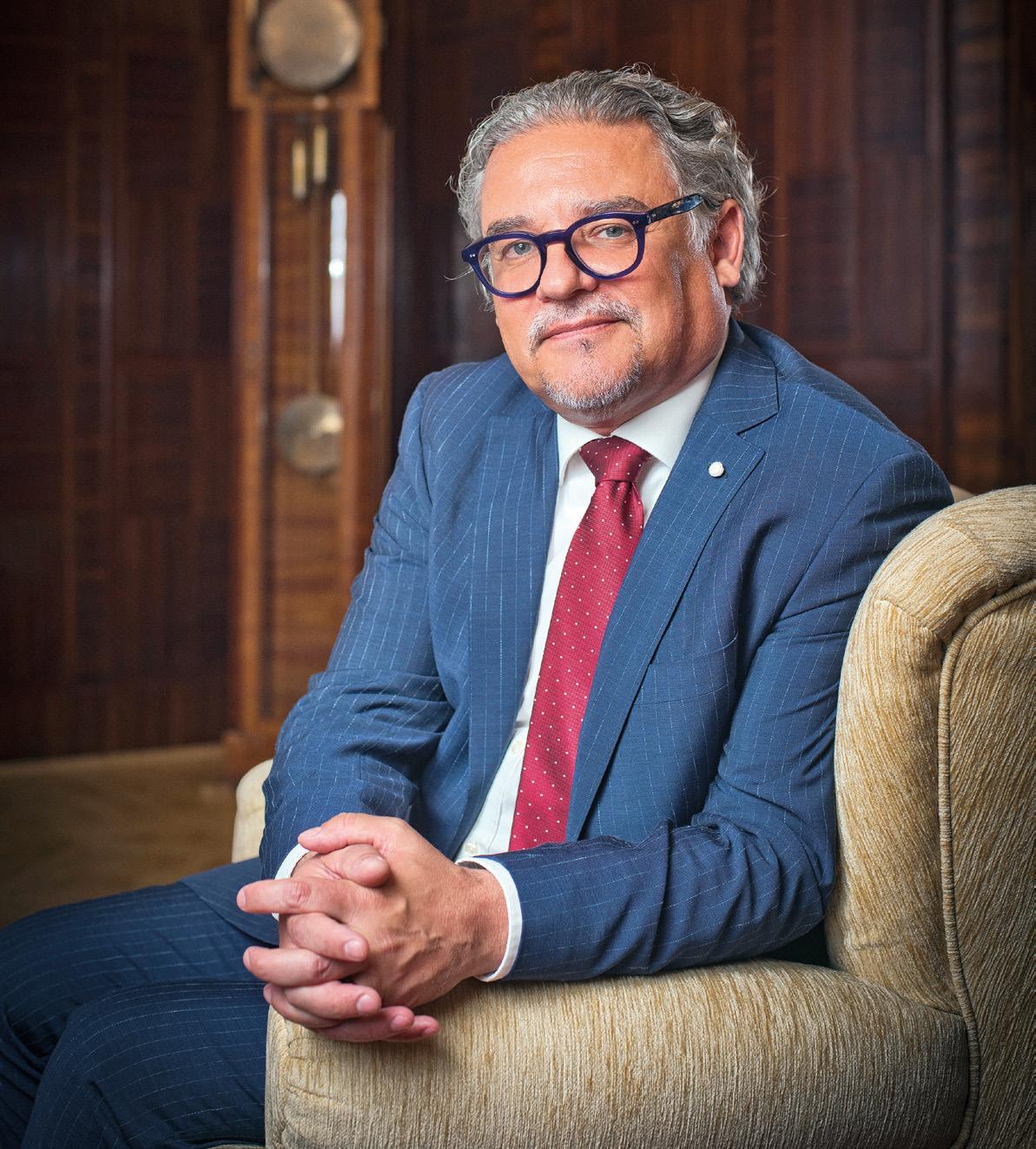
18 minute read
SIGNIFICANT INVESTMENTS OF CZECH INVESTORS IN SERBIA
EXCLUSIVE
H. E. Tomáš Kuchta
Advertisement
THE CZECH REPUBLIC HAS BECOME AN IMPORTANT FOREIGN INVESTOR IN SERBIA
“The range of interests of Czech investors in Serbia is very broad, and considering the construction boom in your country, the potential for cooperation in this sector is enormous", says Tomáš Kuchta, the Ambassador of the Czech Republic to Serbia. We had the honour to be taken on a tour of the Embassy by His Excellency himself, and have a look at this magnificent edifice in the centre of Belgrade, which has been standing there for a whole century as a symbol of the friendly relationship between our two countries
By:
GORDANA KNEŽEVIĆ MONAŠEVIĆ
Photo:
MILOŠ LUŽANIN
I
t is delightful to be a guest of the Czech Embassy in Belgrade, where you are, as soon as you step on the monumental staircase at the entrance, welcomed on the red carpet. You cannot avoid feeling important as you climb up the stairs, walk down the wide corridor or sit in one of the elegant lounges, knowing that many eminent people stayed and visited there before you during the one-hundred-year history of this building. Looking at the authentic, perfectly preserved early 20th century furniture, one can easily imagine the rustling of ball gowns in the Great Hall with its mirrors, piano, and spectacular chandeliers made of Czech glass, or serious political discussions that gentlemen used to have in the Wooden Lounge, while sipping their Czech slivovitz, and the ladies having becherovka in the Ladies’ Lounge. Great Hall, Wooden and Ladies’ Lounge look the same as before, as showing in the hundred years old photographs, but the protocol has slightly changedBalls have been replaced by concerts and art exhibitions, but guests are still being served with Czech slivovitz and becherovka, a famous bitter-sweet liqueur. Depending on the occasion and the menu, excellent Czech white wines are also served, as well as the finest Serbian red wines and, of course, unchallengeable Czech beer. Beautiful glasses made of the finest Czech glass, proudly lined up in the glass showcase in the Wooden Lounge, provide the final touch to this exquisite atmosphere. „I travelled extensively and saw many Czech embassies around the world, but none of them are like this one. When this Embassy was built, almost one hundred years ago, the best of Czech architecture and Czech products were woven into it, and this mixture of cubism and functionality remains unmatched even today“, says His Excellency Tomáš Kuchta, who has proven to be an outstanding host and converser. Not only because he is an experienced diplomat, having been in several successful diplomatic missions in Rome, Brussels and Zagreb, but also because he is familiar with every nook and corner of the Embassy and its history, not to mention that he speaks Serbian fluently. He has been an ambassador to Serbia for the past four years, during which time he and his family have come to love Belgrade as their second home.
The Embassy building of the Czech Republic is one of the oldest and few diplomatic buildings in Belgrade that were built for this specific purpose. How does it feel to work in a century-old historical edifice that has museum values, considering that most of its original furniture and decorations are still intact?
— It is an honour to work on the premises of one of our most beautiful embassies in the world. At the same time, it is a big responsibility because this property should not only be preserved but also, if possible, handed over to our successors in a better condition than when we assumed the responsibility for it. This will be, I believe, made possible for me and my associates, thanks to the recently completed extensive reconstruction.
The building was designed by the Czech architect Alois Mezera, a representative of the Prague school of modern architecture, who introduced this new trend in Serbia by making this very building. Which types of chambers and quarters may be found in this monumental building of subdued elegance?
— This monumental edifice is, actually, one of the few embassies that were built with this specific purpose, so that it contains everything that one diplomatic mission may need, and maybe even more than that. Its location, characteristic architecture, and the careful consideration with which it was designed, built, and eventually furnished, are the most reliable evidence of the close and friendly relationship between our countries at that time, which still applies to our countries today, because I can confidently say that this friendship persists to this date, both between our two nations and the representatives of our two states.
Apart from the representative premises used for meetings, receptions, concerts, and other events, and also the official premises necessary for the everyday functioning of the Embassy, there are a number of living units used by the Embassy employees and their families, a recreation space which had once been used as a school, and a tucked-away pleasant courtyard, a true little oasis in the centre of the city.
What is your favourite part of the Embassy, and which quarters and attractions do you usually present to your guests?
— My favourite is the Wooden Lounge. It is very pleasant and, according to the old photographs, almost preserved in its original state. However, I do admire all the representative rooms, crystal chandeliers, Max Švabinský painting, and the piano, which happens to be one of the best in Belgrade. I would also like to show the visitors our official premises, so that they can see how this building was designed smartly and in line with functionalism. It is incredible how it still responds to all requests made in modern times.
During one century, many distinguished personalities stayed in or visited this building, from kings to presidents, and some important events took place here. Can you tell us some curiosities from this building’s rich history?
— Certainly, the most significant historical event that took place in the Embassy building is the unconditional surrender of the Kingdom of Yugoslavia, signed on April 17, 1941, which by this act ceased to exist and was subsequently partitioned. Understandably, at that time, the building was controlled
Wooden Lounge used to be a salon for gentlemen
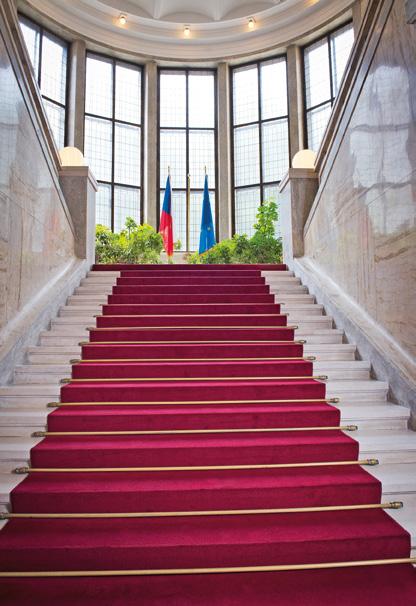
Stairs at the entrance to the embassy The meeting room where the capitulation of Yugoslavia was signed in 1941

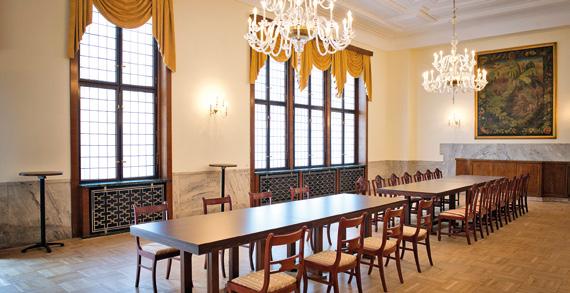
by the German Ministry for Foreign Affairs, which took command of it in the spring of 1939, following the dissolution of Czechoslovakia.
There is another historical moment I would like to mention, which did not take place inside the building but in front of it. It was in 1968, when, as a reaction to the occupation of Czechoslovakia, a large gathering of Yugoslav citizens took place in front of the Embassy to express their support for Czechoslovakia. According to contemporary testimonies, it was the largest gathering in the former Yugoslavia, with around 100,000 people.
The construction of the Embassy building was, at that time, between the two world wars, a symbol of exceptional relations between the two countries – Czechoslovakia and Yugoslavia. Relations between the Czech Republic and Serbia are also excellent at all levels of cooperation. What is it, in your opinion, that is crucial for close ties and good relations between our two countries?
— As you said, the embassy building is a symbol of exceptional relations. That period was marked not only by excellent relations between our countries and peoples, but also by sincere and friendly relations between the representatives of our states, our President Tomáš G. Masaryk and your King Aleksandar I Karadjordjević. It is not a coincidence that our Embassies are located in the very centres of the two cities – ours in Belgrade in the King Aleksandar Boulevard, in the vicinity of the National Assembly and the Presidency, and yours, in Prague, in a gorgeous villa located in the vicinity of the famous Charles Bridge. These locations also serve as an evidence of these friendly relations.
Relations between our countries are traditionally good, throughout history and today. We never had any outstanding problematic issues that could endanger this close friendship, and we maintained continuous ties. So, for example, the idea of studying in Czechia remains popular here, and we are always proud to point out that some of the important names in Serbian society are actually “Czech students“. Although the best known ones are those in the film industry, they are actually present in all segments of society. And it is they who spread the good word about the Czech Republic in their respective

Ladies’ Lounge The painting “Hradčany“ by Václav Radimský from 1938
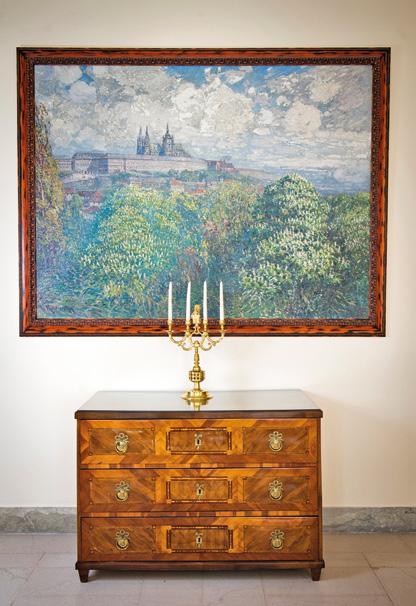

Concerts and exhibitions are held in the Great Hall today
The clock and the candlestick, which adorns the Wooden Lounge, have been part of the embassy’s inventory since its opening

milieus. There is a continuity of contacts in all other fields, too – economy, culture, politics, etc. I think it is these traditionally friendly relations and contacts throughout history, as well as our awareness of them, that keeps us close even today. We have inherited these close and good relations between our countries from some earlier generations, and it is our responsibility to maintain them, if not even to advance them.
Economic relations between our countries are highly developed. One of the proofs is the intensive activity of the trade and economic department of your Embassy, but also your personal engagement, considering the fact that you are an economist by profession and that you were involved in this particular sector in your previous missions, too. What is the focus of Czech investors in Serbia?
— It is my great pleasure to confirm that Czechia has become a very significant foreign investor in Serbia. The scope of interests of the Czech companies is very broad and, actually, it is hard to point out one particular trade sector as being in the focus of the Czech investors. Instead, I would prefer to present to you some of the most interesting investments made by Czech companies in the past few years.
It is, for example, an investment of the SEBRE company in the film centre Avala Studios Belgrade, or their project Marina Dorćol; the investment entry of the PPF group in Telenor, now Yettel communication company and Serbian mobile banking; the investment entry of the PENTA - Dr. MAX group in the farmaceutical chain Farmanea; the acquisition of the Knjaz Miloš company by the company Mattoni from Karlovy Vary; the acquisition of the state company for aircraft maintenance – JAT-Tehnika, by the Avia Prime consortium; and the investment of the company IMG Automotive in the Vršac municipality, where there is a large Czech community. I would also like to mention the Czech real estate group, UDI Group, which is successfully realizing and developing residential and business buildings in Belgrade. Another important investment is last year’s investment entry of the Czech company CE Industries into the Serbian Beohemija.

The expansion of the real estate industry in Serbia has attracted a significant number of investors, some of whom are developing large-scale projects – residential, business and industrial. How satisfied are they with the business-friendly environment in Serbia, and do you expect more Czech real estate investors to come here?
— As a response to your question, I would like to share with you details of two interesting projects developed by a Czech investor in Serbia. The first one refers to Avala Film Belgrade – which is Serbia’s’ family silver’, the largest film studio in Serbia, established in 1946 as the first film studio in postwar Yugoslavia. The Czech investor, SEBRE company, comes here with a plan to place this film studio back among the leading centres of film production in Europe, i.e., in the very place that Avala Film occupied until the 1990s of the last century. SEBRE is planning the modernisation and knowledge transfer of active European film studios, such as the Barrandov film studio in Prague. The ultimate goal is to produce new films and digitalize old ones. The complex extends over 40,000 sqm, and the plan is to completely modernize outdated and dysfunctional facilities. In December 2019, the project was designated as “The project of particular importance for the Republic of Serbia”.
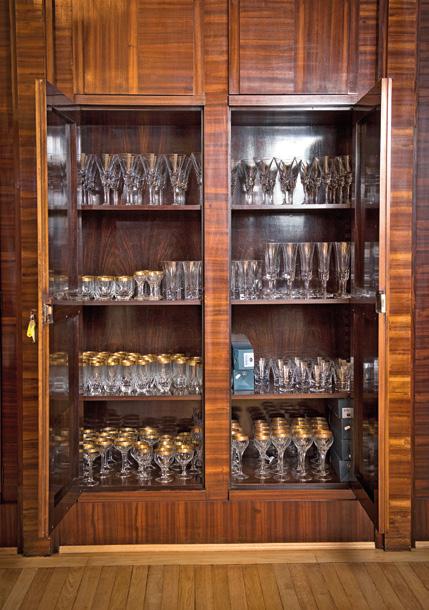
Czech glass cups are lined up in a case in the Wooden Lounge
I would like to add that the investment in the film studio is linked to the residential development project, with a particular focus on the high quality of environmental protection. The author of the residential area is a renowned Czech architect, Stanislav Fiala, who is a winner of many awards in the Czech Republic – the architect of the year and for the construction building of the year, among others. Construction of around 3,000 apartments for 8,000 people is planned within this project, including a school, kindergarten, and a community health centre.
The Czech company SEBRE actively participates in another significant construction project, named Marina Dorćol. This project envisages the construction of an urban complex on the Danube embankment at a walking distance from the very centre of Belgrade. Within an area of 76,000 sqm, a revitalisation of the original railway is planned, as is the construction of a residential building with retail spaces on the ground floor, directly connected to the embankment and offering all urban conveniences. In the vicinity of this 4.15 hectares area there is an old coal thermal power plant from the 1930’s, where
Czech glass chandeliers in the Great Hall
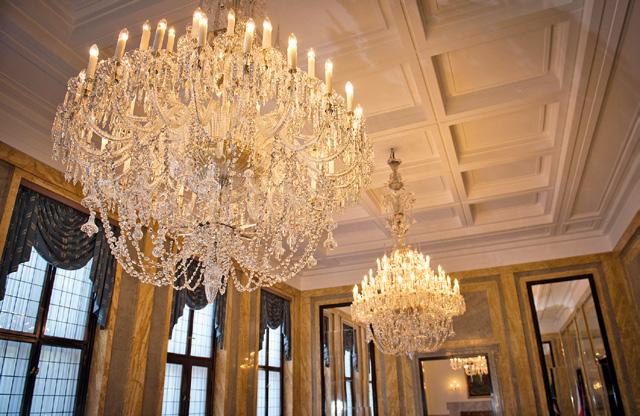
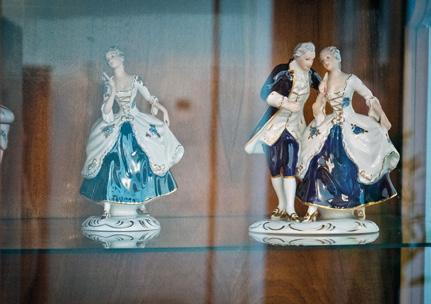
Porcelain figurines are a trademark of the Czech tradition
one of the most important Serbian museums will be moved to – that of Nikola Tesla, one of the giants of world science and innovation.
There were many Czech exhibitors at the recently held Construction Fair, which you visited on the very first day. What is it that the Czech companies of this profile offer to the Serbian market?
— In this year’s international building trade fair SEEBBE 2022, which was held from 27 to 30 April at the Belgrade Fair, the Czech Republic had its national exhibition stand, organised by the Czech state agency CzechTrade. A total of eight Czech exhibitors were registered as interested in the Serbian market. Following companies expressed their interest in cooperation with potential partners in the Serbian market: Plast Brno, a manufacturer of elements for internal waste systems; MFC-Morfico, which offers floor systems (anhydrite and cement subfloors) and arbolite blocks; Fortemix, a family company producing industrial floor systems; Berndorf Baderbau, renowned manufacturer of luxurious swimming pools, jacuzzis and wellness equipment. I would also like to mention the Doornite company, the largest manufacturer of doors in the Czech Republic. Having talked with the representatives of these companies, I am glad to confirm their huge interest in the Serbian construction market. Considering the current construction boom in Serbia, the potential for future cooperation is enormous, and I believe that our companies and their products have great chances to become successful here.
How would you describe the housing market trends in Czechia? How are investors and construction companies coping with the latest crisis and its effects on prices, materials, and real estate itself?
— In my opinion, the real estate market in the Czech Republic is at a crossroads. Becoming an owner of your own living space is becoming a non-viable option in many places in Czechia. For some people, it is for financial reasons, and for others, it is simply because there is not enough on offer on the market. As of last year, there has been a huge problem with a shortage of some construction materials, which resulted in an extreme price rise of these materials and, consequently, of real estate. For example, the market price of aluminium last year was 2,209 USD per tonne, and now it is 3,528 USD, or 60% higher. Aluminium is one of the key materials in construction. Even a 100% increase in price is no longer unusual. The “crises of material” also refers to supplies of steel, wood, and copper, as well as isolation material and brick material.
All this has consequences for the Czech real estate market, which is, among other things, dealing with stricter mortgage loans, including higher interest rates resulting from the interest rates prescribed by the Czech National Bank. Nevertheless, demand for apartments is not decreasing and it is expected to remain higher than supply in the next few years.
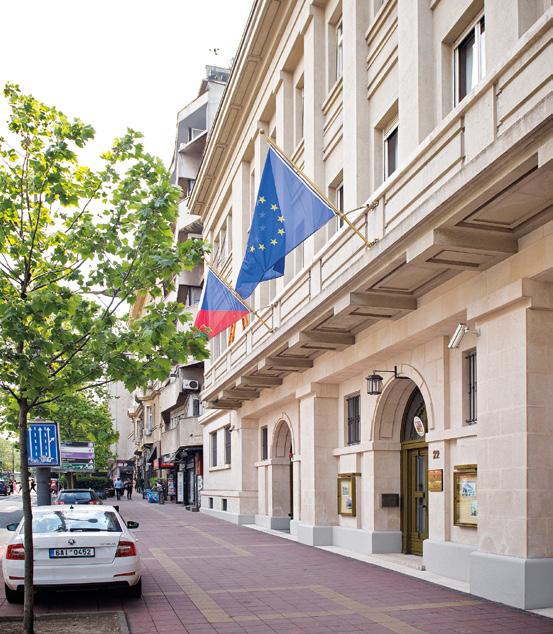
The embassy building is located in the very centre of the city, at the beginning of King Aleksandar Boulevard
Czech culture – not only the architecture mentioned above, but also the film school – has always had a significant influence on our artists and intellectuals. What is our cultural cooperation like today?
— The Czechs are particularly proud of these two creative fields that you just mentioned. Czech architects made a significant impact on Serbian architecture. There is no need even to go into details here; it’s enough to mention just a few buildings that come to mind right away – for example, Captain Miša’s edifice, which today serves as the home to the Belgrade University; Novi dvor, today’s seat of the President of the Republic of Serbia; and the Astronomical Observatory in Zvezdara; all these are works of Czech architects. When it comes to the film school, everyone knows that some of the most renowned names
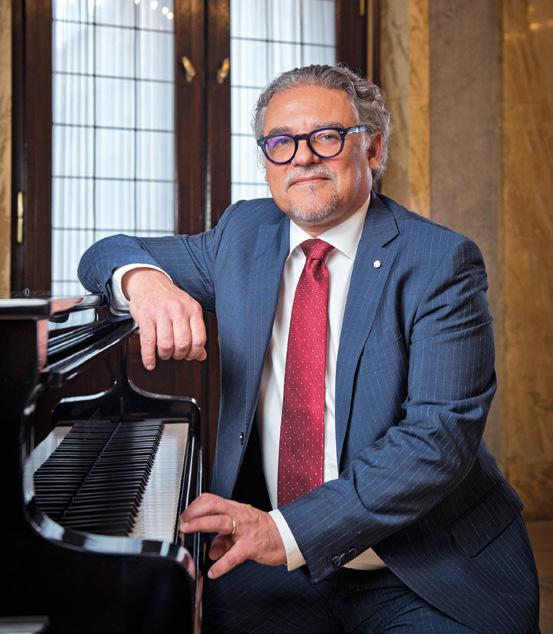
The piano in the Great Hall was produced a century ago and is one of the best in Belgrade in Serbian cinematography are Czech students – Goran Marković, Emir Kusturica, Goran Paskaljević, Srdjan Karanović...
Throughout history, our cooperation in these areas corresponded to the pace of cooperation in other fields, so it was highly developed. And it remains so even today. Even today, Serbian artists and scientists are enthusiastic about cooperation with Czechia and vice versa. These contacts slowed down due to the pandemics, of course, but we are confident that very soon they will resume with the same intensity as before. Our Embassy is within its competence and possibilities to try to mediate these contacts, and we are also encouraging all direct contacts between artists and scientists and the institutions they belong to, which are also numerous, thanks to the earlier mentioned traditional close contacts between our two nations.
How often do the Czechs and Serbs visit each other? What would you recommend your fellow countrymen to see in Serbia, and where would you take us if we were to be your guests in Prague?
— The Czechs and Serbs visit each other a lot. Our two nations are connected by common history and Slavdom. In Serbia, we can follow a historical trail left by the Czechs, dating from different periods of Serbian history, in many different areas and in numerous locations. Some of these names are well known, some are forgotten, but their accomplishments have helped to build good relations between the Czech and Serbian nations. Another important role of the Czechs in Serbia was their “know-how” in the glass, confectionary, and beer industries, as well as some other trades. We still have a significant Czech community in Serbia, especially in Banat.
The Czechs like to visit Serbia, particularly for its natural beauty, and they also like to visit the historical centre of Belgrade, Novi Sad, Niš, Kragujevac, and other towns, as well as Banat, where, apart from the natural beauty, they are attracted by the trails of Czech history and folklore.
When it comes to tourism in Czechia, apart from Prague, the Czech Republic offers many other historical places such as esk Krumlov, Olomouc, Tel, Kutná Hora, numerous spas such as Karlovy Vary and Mariánské Lázn, natural beauties, many beautiful castles and fortresses, wine-producing regions and many other places.
I would certainly recommend Serbian tourists visiting Prague to take a tour of the historical city centre with its numerous cultural monuments and, after that, to taste the Czech cuisine and beer.
How do you like your life in Belgrade, where you have been serving as an ambassador for the past four years? Do you have your favorite places for socializing and relaxation, and do you manage to ride your bicycle around the town?
— Life in Belgrade is very pleasant for a Czech; many things are the same as in Prague, sometimes even better, such as, for example, hospitality. On the contrary, neither I nor my family have ever encountered any serious problems here. Wherever we say that we come from Czechia, we are always met with positive responses. We always find a common topic to discuss, be it history, culture, travel, architecture. I grew to appreciate the Ada Ciganlija neighborhood, a lovely spot in the heart of Belgrade that allows its residents to participate in sports or simply relax. My son has his football training there regularly, while my wife and I avail ourselves of that time to take long walks with our dog. This gives us the opportunity to watch in continuity how residents of Belgrade actively spend their time and how this whole area keeps changing for the better. When I have time over the weekend, I like to take a long ride on my bicycle. Usually I ride by the river, so the last part of my trip is the hardest, as I have to ride up one of the steepest climbs in Belgrade to get back home.










